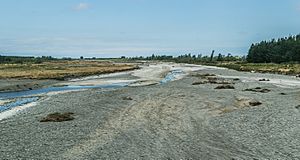Selwyn River / Waikirikiri facts for kids
Quick facts for kids Selwyn River |
|
|---|---|
| Lua error in Module:Location_map at line 420: attempt to index field 'wikibase' (a nil value).
Location of the mouth within New Zealand
|
|
| Native name | Waikirikiri |
| Country | New Zealand |
| Physical characteristics | |
| Main source | Southern Alps |
| River mouth | Lake Ellesmere / Te Waihora |
| Length | 80 km (50 mi) |
The Selwyn River / Waikirikiri flows through the Selwyn District of Canterbury in the South Island of New Zealand.
Contents
Description
The river has its source in the Southern Alps and flows east for 80 kilometres (50 mi) before emptying into Lake Ellesmere / Te Waihora, south of Banks Peninsula. Terrace cliffs above the river's upper reaches gave the town of Whitecliffs its name.
For much of its course the river flows through wide shingle channels. In drought years, the river can disappear beneath this bed and seem to dry up completely. This frequently occurs where State Highway 1 crosses the river at the settlement of Selwyn, about 20 kilometres (12 mi) upstream from its outflow into Lake Ellesmere.
In the foothills, the Selwyn flows year-round. On the plains, the riverbed is highly permeable, and the river overlays a deep and porous aquifer. As soon as the river reaches the plains, water begins leaking down through the bed and into the aquifer. In most months, all river-water disappears within 5 kilometres (3 mi) of leaving the foothills. The next 35 kilometres (22 mi) of the river remains dry for most of the year, apart from a small section around the confluence with the permanently flowing Hororata River. About 15 kilometres (9 mi) upstream from Lake Ellesmere shallow groundwater rises back to the surface, and the Selwyn becomes permanent again.
Ecology
Disappearing river flows have significant ecological effects: when the river’s surface water disappears, so does the habitat for many aquatic plants and animals. In response to loss of surface water, aquatic invertebrates and fish must disperse, seek refuge in remnant aquatic habitats, or die. Aquatic plants, algae, and bacteria must form resting stages or die. The dry central reaches of the Selwyn River also constitute a significant barrier for dispersal of invertebrates and for fish migrating between Lake Ellesmere and the headwaters.
Naming
The Selwyn River and its gorge were named in 1849 by the chief surveyor of the Canterbury Association, Joseph Thomas, for Bishop Selwyn. The name was later adopted for the township, the district, and an electorate.
The New Zealand Ministry for Culture and Heritage gives a translation of "gravelly stream" for Waikirikiri.
Images for kids
-
Result of flooding on the Selwyn River - Glentunnel, NZ. June 2021
See also
 In Spanish: Río Selwyn / Waikirikiri para niños
In Spanish: Río Selwyn / Waikirikiri para niños



